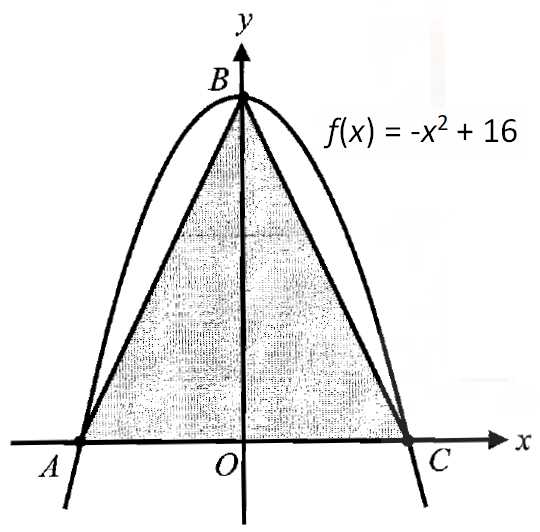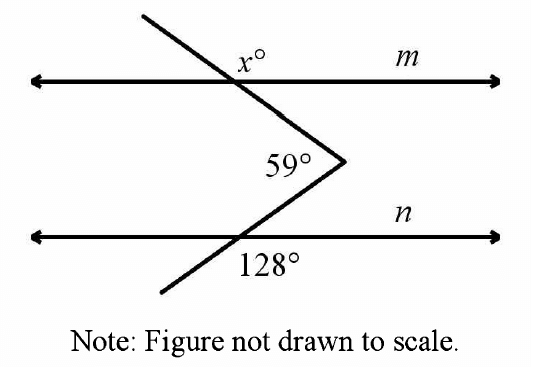TRIANGLES WORKSHEET
Question 1 :
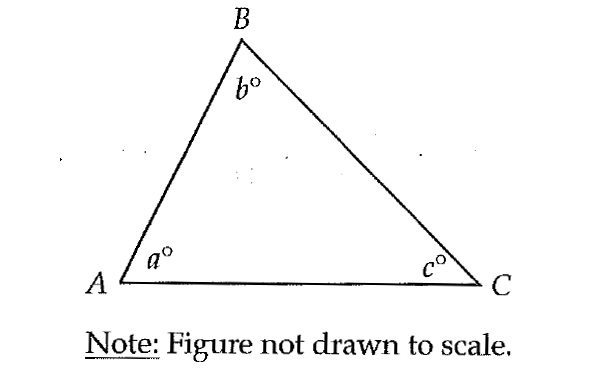
The triangle above is isosceles and b > a. Which of the following must be FALSE?
A) AB = BC
B) AB = AC
C) AC = BC
D) a = c
Question 2 :
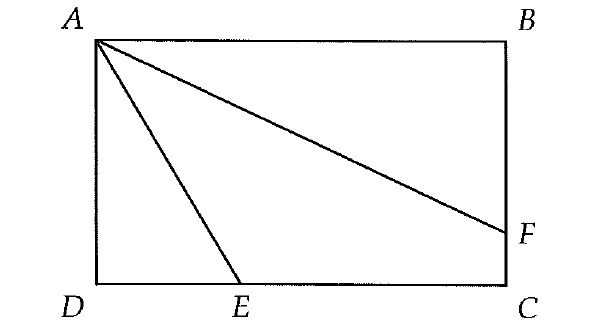
In rectangle ABCD above, E is on DC, F is on BC, DE = 6 and FC = 1. If angle A is trisected (divided into three equal angles) by AE and AF, what is the length of BF?
A) 5
B) 5√2 - 1
C) 5√3 - 1
D) 6√3 - 1
Question 3 :
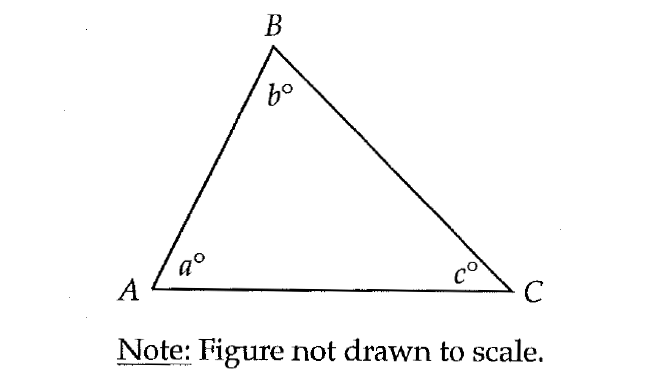
In the figure above, AB = AC and c° = 50°. What is the value of a?
A) 65
B) 70
C) 75
D) 80
Question 4 :
The lengths of the sides of a triangle are different prime numbers. If two of the sides have lengths 3 and 11, which of the following could be the length of the third side?
I. 7
II. 13
III. 17
A) I only
B) II only
C) I and II only
D) I, II and III
Question 5 :
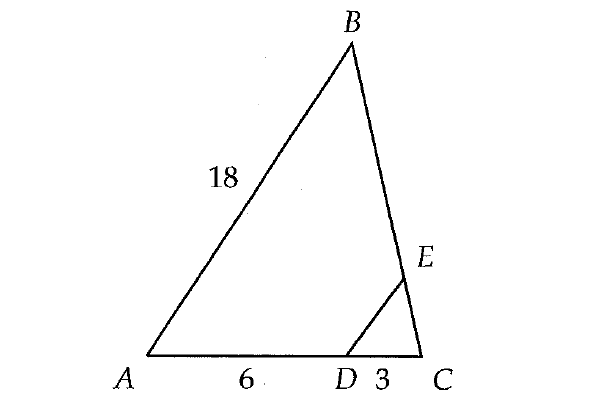
In the figure above, DE is parallel to AB. If AD = 6, DC = 3 and AB = 18, what is the length of DE?
Question 6 :
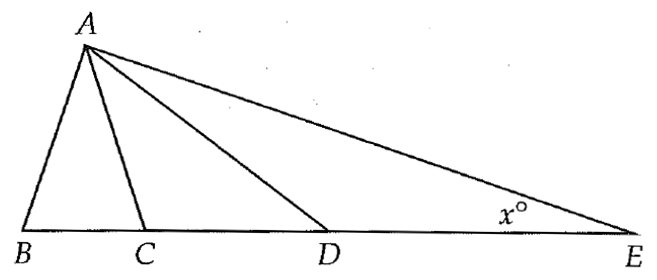
In the figure above, ∠BAC = 20° and AB = AC. If triangles ACD and ADE are isosceles, what is the value of x?
Question 7 :
Which of the following CANNOT be the lengths of the sides of a triangle?
A) 3, 5, 7
B) 3, 24, 24
C) 4, 6, 9
D) 4, 7, 2
Question 8 :
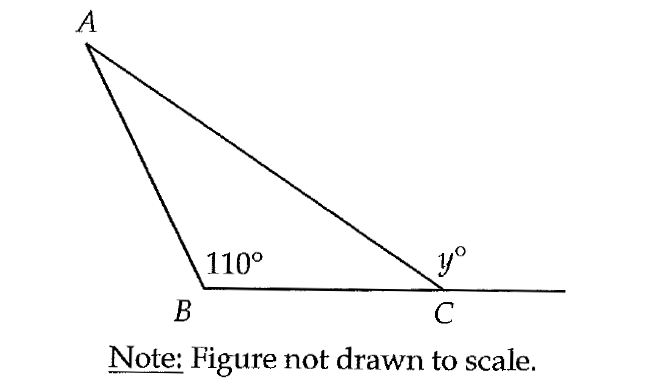
In the figure above, AB = BC and ∠ABC = 110°. What is the value of y?

Answers
1. Answer :

In the triangle shown above, b° > a°. So b° ≠ a°.
AC is the side corresponding to b° and BC is the side corresponding to a°.
Since b° ≠ a°, AC ≠ BC.
But the answer choice (C) says that AC = BC.
So, (C) AC = BC must be FALSE.
The correct answer choice is (C).
2. Answer :
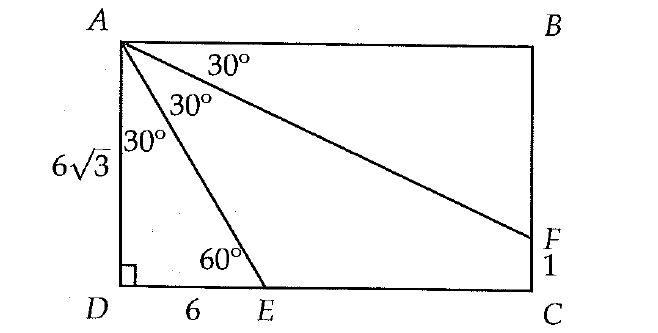
ΔADE is a 30° - 60° - 90° triangle.
DE is the shortest leg, because it is opposite to 30° and the next longer leg is AD which is opposite to 60° and the hypotenuse is AE.
In a 30° - 60° - 90° special right triangle, length of the of the shortest leg is always assumed to be 'x'.
Then, the lengths of other two legs in terms of 'x' :
Length of the longer leg = √3x
Length of the hypotenuse (AE) = 2x
So, the length of AD :
= √3(6)
= 6√3
In a rectangle, opposite sides are always equal in length.
Then,
BC = 6√3
BF + FC = 6√3
Substitute FC = 1.
BF + 1 = 6√3
Subtract 1 from both sides.
BF = 6√3 - 1
The correct answer choice is (D).
3. Answer :

In the triangle above, the angle measure corresponding to the leg AB is c° and the angle measure corresponding to the leg AC is b°.
Since AB = AC,
c° = b°
In ΔABc above,
a° + b° + c° = 180°
Since c° = b°, replace b° by c°.
a° + c° + c° = 180°
a + 2c = 180
Substitute c = 50.
a + 2(50) = 180
a + 100 = 180
Subtract 100 from both sides.
a = 80
The correct answer choice is (D).
4. Answer :
Key Concept : In any triangle, the sum of the lengths of any two sides must be greater than the length of third side.
I. 7 :
7 + 3 > 11 ✘
I. 7 does not work.
II. 13 :
13 + 3 > 11 ✔
13 + 11 > 3 ✔
3 + 11 < 13 ✔
II. 13 works in all the ways.
III. 17 :
17 + 3 > 11 ✔
17 + 11 > 3 ✔
3 + 11 > 17 ✘
III. 17 does not work.
The correct answer choice is (B).
5. Answer :

Since DE is parallel to AB, AC and BC are transversals.
∠BAC and ∠EDC are corresponding angles,
m∠BAC = m∠EDC
∠ABC and ∠DEC are corresponding angles,
m∠ABC = m∠DEC
Two angles of ΔABC are congruent to two angles of ΔDEC.
By Angle-Angle Similarity Theorem, ΔABC and ΔDEC are similar triangles Hence, the sides are proportional.
DE/AB = DC/AC
DE/18 = 3/9
Multiply both sides by 18.
DE = 6
6. Answer :

In ΔABC, the angle corresponding to the side AB is ∠ACB and the angle corresponding to the side AC is ∠ABC.
Since AB = AC,
∠ACB = ∠ABC
In ΔABC,
∠BAC + ∠ABC + ∠ACB = 180°
20° + ∠ABC + ∠ACB = 180°
20° + ∠ABC + ∠ACB = 180°
∠ABC + ∠ACB = 160°
∠ABC = ∠ACB = 80°
In the figure above, ∠ACB and ∠ACD together form a linear pair.
∠ACB + ∠ACD = 180°
80° + ∠ACD = 180°
∠ACD = 100°
Given : ΔACD is an isosceles triangle.
So, two of its angles must be equal.
Since ∠ACD = 100°, the remaining two angles ∠CAD and ∠ADC must be equal.
In ΔACD,
∠ACD + ∠CAD + ∠ADC = 180°
100° + ∠CAD + ∠ADC = 180°
∠CAD + ∠ADC = 80°
∠CAD = ∠ADC = 40°
In the figure above, ∠ADC and ∠ADE together form a linear pair.
∠ADC + ∠ADE = 180°
40° + ∠ADE = 180°
∠ADE = 140°
Given : ΔADE is an isosceles triangle.
So, two of its angles must be equal.
Since ∠ADE = 140°, the remaining two angles ∠AED and ∠DAE must be equal.
In ΔADE,
∠ADE + ∠AED + ∠DAE = 180°
140° + ∠AED + ∠DAE = 180°
∠AED + ∠DAE = 40°
∠AED = ∠DAE = 20°
Given : ∠AED = x°.
Therefore,
x = 20
7. Answer :
Key Concept : In any triangle, the sum of the lengths of any two sides must be greater than the length of third side.
Choice (A) :
Given side lengths : 3, 5, 7.
3 + 5 > 7 ✔
5 + 7 > 3 ✔
3 + 7 > 5 ✔
3, 5, 7 can be the lengths of the sides of a triangle.
Choice (B) :
Given side lengths : 3, 24, 24.
3 + 24 > 24 ✔
24 + 24 > 3 ✔
3 + 24 > 24 ✔
3, 24, 24 can be the lengths of the sides of a triangle.
Choice (C) :
Given side lengths : 4, 6, 9.
4 + 6 > 9 ✔
6 + 9 > 4 ✔
4 + 9 > 6 ✔
4, 6, 9 can be the lengths of the sides of a triangle.
Choice (D) :
Given side lengths : 4, 7, 2.
4 + 7 > 2 ✔
7 + 2 > 4 ✔
4 + 2 > 7 ✘
4, 7, 2 CANNOT be the lengths of the sides of a triangle.
8. Answer :

In ΔABC, the angle corresponding to the side AB is ∠C and the angle corresponding to the side BC is ∠A.
Since AB = AC,
∠C = ∠A
In ΔABC,
∠A + ∠B + ∠C = 180°
∠A + 110° + ∠C = 180°
Subtract 110° from both sides.
∠A + ∠C = 70°
Since ∠C = ∠A and ∠A + ∠C = 70°,
∠A = ∠C = 35°
In the figure above, ∠C and y° together form a linear pair.
∠C + y° = 180°
35° + y° = 180°
y = 145
Kindly mail your feedback to v4formath@gmail.com
We always appreciate your feedback.
©All rights reserved. onlinemath4all.com
Recent Articles
-
Digital SAT Math Problems and Solutions (Part - 143)
Apr 13, 25 12:01 PM
Digital SAT Math Problems and Solutions (Part - 143) -
Quadratic Equation Problems with Solutions
Apr 12, 25 08:21 PM
Quadratic Equation Problems with Solutions -
Digital SAT Math Problems and Solutions (Part - 142)
Apr 11, 25 06:26 PM
Digital SAT Math Problems and Solutions (Part - 142)
